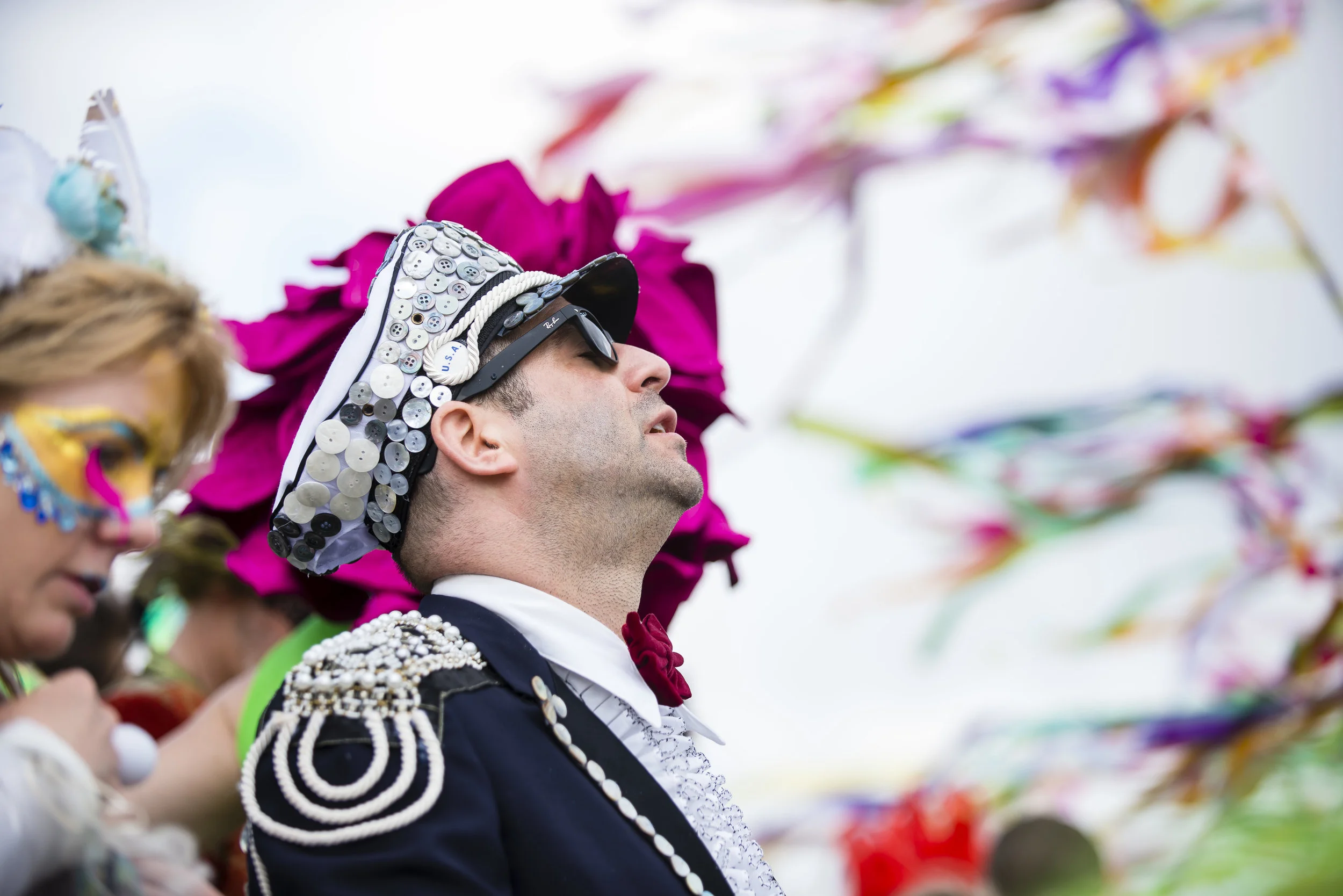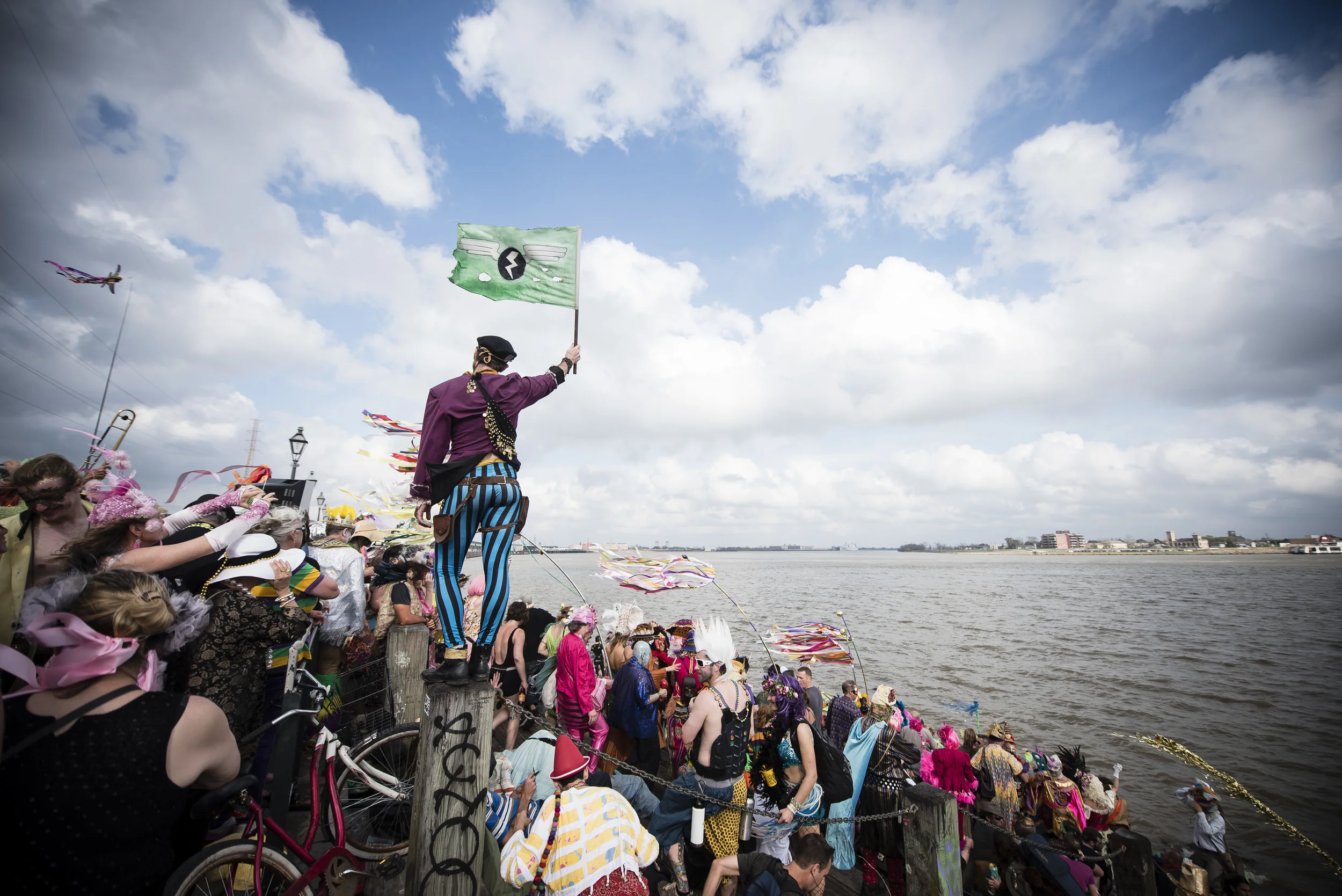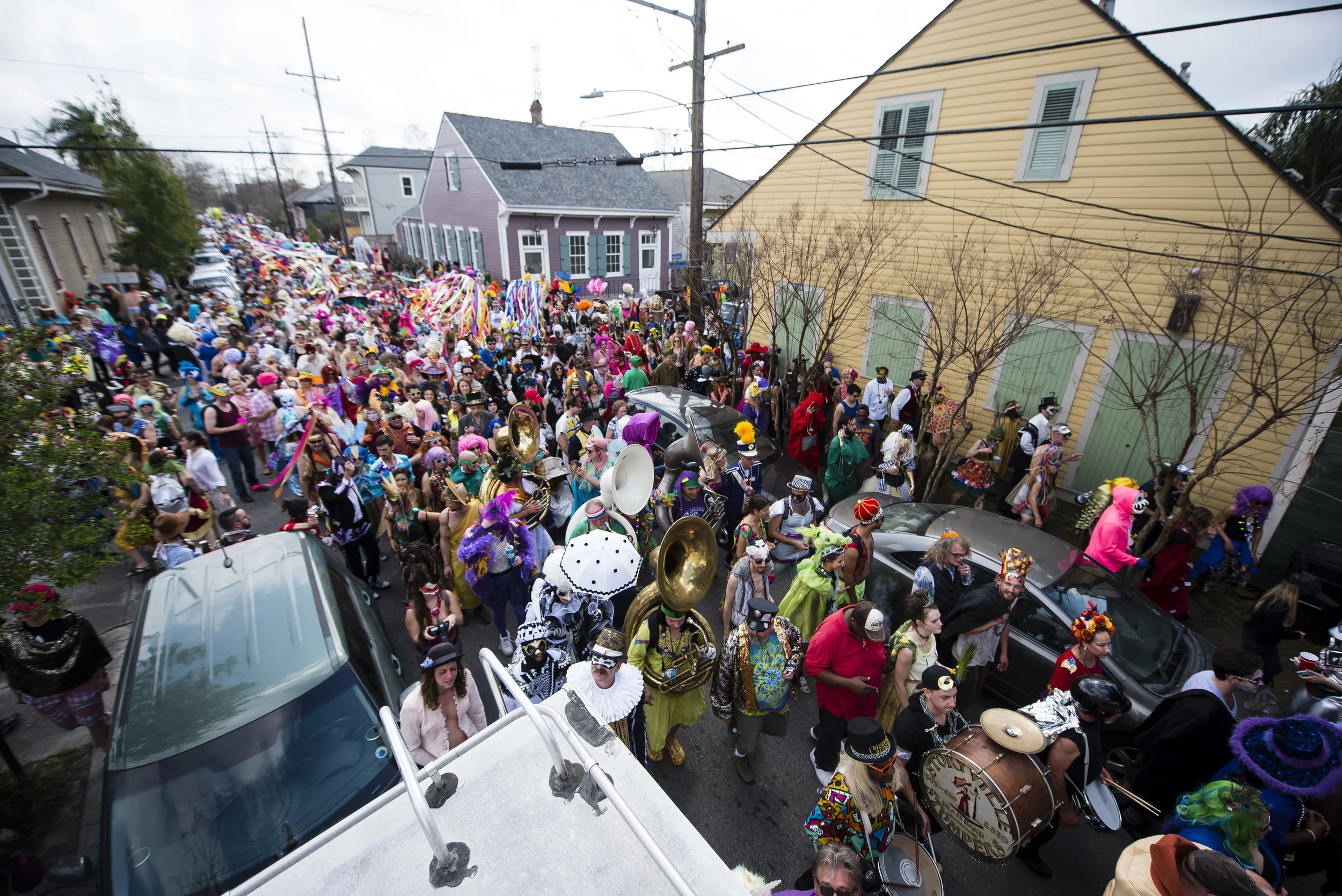Happy Mardi Gras, y’all. If you’ve ever been infected by the spirit of New Orleans during Carnival, you might understand the desire to live in that spirit for all time. Today, we visit a little krewe whose job it is to make that happen — by marching the ashes of the departed to the banks of the Mississippi River.
Story by Phoebe Zerwick | Photographs by Christine Rucker
L-R Lanie Dornier, David Christensen, and Jon Fast sit outside Vaughan's bar in the Bywater neighborhood of New Orleans a couple days before Mardi Gras. Jon traveled from San Francisco to carry the ashes of his father to the river with the Saint Anne's Krewe. David also traveled from San Francisco to be there in support of John.
A warm breeze blows through Vaughan’s Lounge, a corner bar in the Bywater neighborhood of New Orleans. It’s February 2017, three days before Mardi Gras.
Cindy Wood, who runs Vaughan’s, got up early to get dressed in the green, sequined gown she wears every year to walk in the Secret Society of Saint Anne’s marching parade. She and her friend Robyn Halverson will bring the Storyville Stompers Brass Band over to Burgundy Street, to lead the parade from the 9th Ward into the French Quarter, then up to St. Charles and down to the Mississippi River.
That’s where Wood and her krewe have been scattering ashes of the dead for the last 30 years.a
Robyn Halverson, one of the organizers of the secret society of St. Anne's, sips a drink as she makes her way through the parade to the river.
Over the years, Wood has put close friends in the river — plus two dogs and her father, Daddy-O-On-The-Patio, whose ashes she scattered back in 2002. She keeps the rest of Daddy-O’s ashes in a box behind the bar. She brings him out to watch the Saints play football. Someday, she says, the krewe will put her in the river, too.
“The city was built on this river and it’s the city that all these people loved,” she says. “It’s like the lifeline of the city.” This year, she’ll march with the ashes of her brother-in-law and dear friend, John Sipos, otherwise known as Cuz with the Buzz, who died in December after years of declining health.
“I’ll be thinking I’m not going to see him again, but I’ll remember him,” Wood said.
Maybe it shouldn’t have surprised me the remains of the dead are so present in New Orleans. The river, two blocks south of Vaughan’s Lounge, is a churning source of life and of death. New Orleans sits in the river delta, and if the Mississippi had its way, it would sweep whatever lies in its path with it to the Gulf, feeding the vast but shrinking estuary of the Mississippi Delta. A series of levees keeps the river from its natural course through New Orleans, unless they break, as they did in 2005 during Hurricane Katrina.
The Mississippi is quiet after all the revelers moved on to bars and parties celebrating Mardi Gras — this location is referred to as the Moonwalk.
The Secret Society of Saint Anne is what people in New Orleans call a neighborhood marching krewe. The marching krewes parade on foot, while the super krewes like Rex and Zulu roll through town on elaborate floats. The Secret Society of Saint Anne formed in the late 1960s, dreamed into being by designers and artists, many of them gay and living in the bohemian Bywater neighborhood. They hired a band, made costumes of satin and beads, or feathers and silver lamé. They affixed hula hoops to tall poles and covered them with ribbons — banners to lead the way. In the early years, the Saint Anne’s parade stopped at the edge of the French Quarter to watch the super krewes and their floats. Then came the AIDS crisis and the Saint Anne’s krewe decided to remember friends and lovers who died the previous year by walking down to the river. They scattered the ashes of men no one imagined would die so young.
Sean Anderson hugs his partner, Blew Velvet, after they scatter the ashes of friends who died.
These days, Halverson and Wood raise money to hire the band, but they no longer track how many people join their parade carrying ashes of loved ones. On our first night in town, we met Marshall Gochenour, who’d come to New Orleans after Katrina to work with a nonprofit that cleared away rubble left by the flood. He won’t talk about what he saw in those houses, the terrible things wrought by a river.
“It is the bringer of life through death,” he told me. He and his girlfriend were going to scatter the ashes of their dog, Stitch, who had kept her safe in the days after Katrina. We also met John Fast, an ad man from San Francisco who had flown in to scatter his father’s ashes. And James Jensen, one of the original members of Saint Anne’s, who was helping a dear friend’s widow divide up his ashes into 40 satchels for friends to scatter. Halverson had put her mother in the river the year before. This year, she had her brother’s ashes ready, too. Someday, Halverson says, she too will follow.
“It’s the way I want to go,” she says. “Mix me up with some glitter, put me in a funny little bag, and throw me in.”
A woman holds the ashes of her dog, Paco, before putting him in the river.
It is a long walk from the Bywater to the gathering place at the river. We met at 9 a.m. on Burgundy Street. There were ballerinas in tutus and half-naked men in spandex. There were satin gowns and witches’ hats. Costumes made of paper scraps and leaves, others made with pearl buttons and top hats. A wagon accompanies, carrying crates of oranges, a juicer, ice, and vodka — for fresh screwdrivers along the way. The parade marshal kept order with a piercing whistle.
We met a young man from Oakland, California. He had lost friends in that city’s deadly warehouse fire in late 2016. But he married his lover during Mardi Gras, somewhere on St. Charles.
Every once in a while, we’d see Halverson sauntering by in her pointy hat or Wood raising a go-cup in our direction. People threw beads and glitter from the balconies. I got lost in the crowd and the music.
By mid-afternoon, we went on ahead of the parade to stake out a place to film on the rocky embankment beside the flight of wooden steps the krewe would use to get to the riverside.
Mourners were already there, breakaways like us. A woman in peacock blue scattered her mother. Three young women in white with silk flowers in their hair scattered their dogs — Chaco, Paco and Rocky.
The wind blew and in the distance, I saw the ribbons flying from their hula hoops. The band played and voices rose in song.
“We’re going to lay down our sword and shield, down by the riverside, down by the riverside.”
The dancing stopped and the stairway filled with people. I looked for Halverson and Wood and Fast.
Fast’s father went in.
The dog who had kept a woman safe during the chaos after Katrina went in.
And Cuz with the Buzz mixed up with glitter.






















